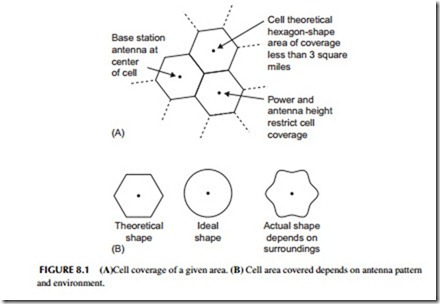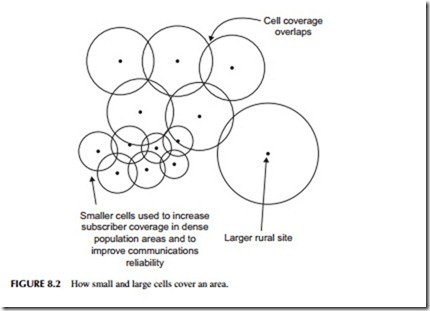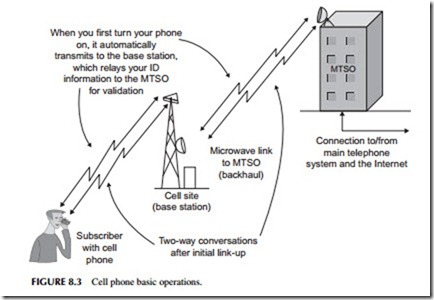THE CELLULAR CONCEPT
The original designers of the cell phone created a system that helps overcome the range and power problem described in the sidebar. If distances are kept
short, then other limitations in power and environment are offset. The working word here is “cell.” A cell or cell site is one of many transmit/receive stations set up to communicate with individual cell phones. Also known as base stations, these facilities are easily recognized by their tall antenna towers. The small building at the base of the tower houses racks of transceivers that share the big antennas at the top of the tower. Long coax cables carry the signals to and from the antenna. They actually look like pipes going up the side of the tower.
Cell phone systems have dozens to hundreds of cell sites. An ideal design is shown in Figure 8.1A . Each cell represents an area covered by the base station antennas. Cell range and overall coverage are deliberately restricted by antenna height and radiation pattern as well as transmitting power. The hexagon- shaped cells are only theoretical. In reality, the shape of the cell is more circular or rather an irregular circular shape because of antenna characteristics and environmental characteristics that affect the cell shape (nearby trees, buildings, etc.) (see Figure 8.1B).
While equal-size cells are desirable and operation more predictable, in the real world, the coverage of each cell depends a great deal on the number of cell phone subscribers as well as the terrain and environment. In large cities with lots of people and buildings, smaller cell sizes are used to increase subscriber capacity and provide the most reliable coverage possible in a given area. Many cities have what are called microcells that may only cover one block or picocells that cover one area of a building. On the other hand, in rural areas and along
major highways, the cell sizes are larger and cover fewer users. The cell cover- age may look more like that in Figure 8.2.
A key feature of the cellular concept is that by keeping the cell sizes small, the frequency channels assigned to cellular service can be reused. One frequency may carry different calls if the cell sites are far enough apart and do not interfere with one another. This frequency reuse concept multiplies the overall number of channels available to handle calls.
One other factor to keep in mind is that in most cities, there are two or more cellular companies vying for your business. Each company has its own cellular system with base stations with coverage that overlays the cell coverage of other companies. The competing systems do not interfere with one another because they usually operate on different frequencies with different radio technology, and the cell phones they support know which base stations to talk to.
One other thing: when you are talking on your cell phone, you are talking to only one base station—typically the one closest to you since both the power and range of your handset and that of the base station are limited. If you are moving (such as in a car), you will eventually leave the coverage area of one cell and enter the coverage area of an adjacent cell. You never really know when this happens, but it is a pretty neat technical trick to make this happen. The process of having your call transferred from one cell site to another automatically is called the hand-off.
All of the base stations are tied to a central office known as the mobile telephone switching office (MTSO). Many companies simply refer to it as the switch, as its main job is switching between base stations as well as linking to
the main telephone system. The connection between the base stations and the switching station can be by copper cable or fiber optic cable or in many cases by a separate microwave wireless link. This is known as backhaul. If a cell site tower has one or more small “dish” antennas on it you can bet that your signal eventually is communicated back to the switch via another wireless link.
The big job of the MTSO is to control and keep track of everything. It validates you as a subscriber when you turn on your phone and make a call. It keeps track of how many minutes of time you use. And it will get messages from remote switches when you are in the roam mode outside of your usual home subscriber area. The cell phone companies have the ability to use other systems in most major cities and in many foreign countries, so you can use the phone virtually anywhere. Figure 8.3 shows just what goes on when you turn on your phone and make or receive a call.


